
or Tethered Racing

While Henri was developing diesel slot car racing he was developing racing engines for aero-modellers. Then he returned to his own love of cars and decided to build them to enter competitions. At that time the Americans had developed a system for racing cars one at a time against the clock by tethering the car at the side by a high-tensile braided wire to a pole in the centre with a pivot that was usually ball-raced. It was smelly, noisy and a lot of fun. The competitive element always makes any sport or hobby exciting. Henry was interested in the newly developing interest in his diesel production, and decided to bore oversize one of his BMP 3.5cc engines that he had in production now to 5cc, which was a recognised race class, whereas the production engine was not, so it was at a disadvantage. Henri took three of us, the now late, Michael 'Mick' Flew, Alan Arnold and myself, in an old pre-WW2 Ford Prefect, to Eaton Bray Airfield, in Bedfordshire to assist him in his first competition race. The Eaton Bray track was 150 feet radius, according to the Daily Express, but, from what I remember, that was more like the diameter, not the cable-length, but please let me know if you know otherwise. Some of the top runners were regularly achieving over 100 mph. In the morning practice our car was fastest by far in its class and we had great hopes and got very excited. Unfortunately, the helpers were not the only ones who got excited, because Henri did so too. As the time came for our turn we all stood in expectation of a new world record, everybody that had seen the practice must have thought the same. The competitors only had one run, and so it was essential to get everything correct. Henri always started the diesel on low compression for easiness, then increased compression by turning down the compression screw, just before launch. In his excitement he closed down the cowling and forgot to turn the setting screw down, so everybody stood and watched the car burble around very slowly lap after lap. Nothing could be done. This was not one of Henri's best moments, I thought his face would explode during the next hour. Henri seldom made mistakes, and he was not pleased that he did so in front of a large audience. Below is a copy of a report on that meeting from Model Cars magazine Feb/Mar 1947:
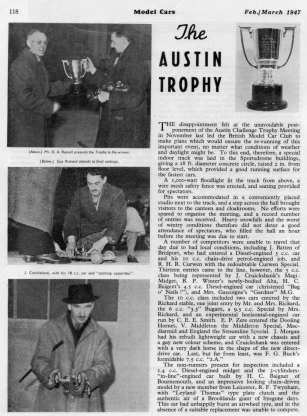
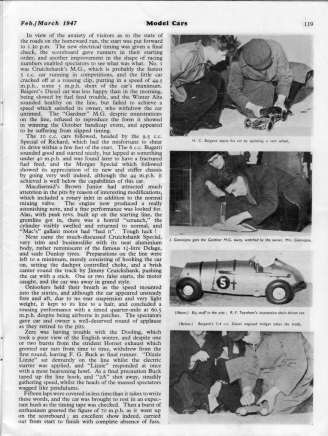

click on images for readable enlargements
Most Sundays, we had regular happy club meets at Holmsley, in the New Forest Hampshire, on a disused wartime aerodrome, near Christchurch, where some of my American readers fathers/grandfathers would have flown missions in Flying Fortresses, Martin Marauders, Douglas Havocs and Bostons during the 1940s. We would hammer the centre pin into the tarmac, sweep the track and have a whale of a time running our cars.
above, an article from Model Car News, click on image to read. The top picture was taken on a day out to Holmsley Aerodrome in the New Forest forflying and car tether racing. No.38 was fitted with our wired racing tyres but this was before the spoked wheels were created.

Here is a picture of Bill Gilbert with an early HB Austin Racer and a very early HB Maserati filling its tank with very hot fuel, we made our own fuels! Bill was a very good friend, he had just been de-mobbed from the Royal Air Force, where he had been a fighter-bomber pilot flying Bristol Beaufighters, and then training pilots to fly Dakotas (DC3s). We spent many hilarious hours together, both with the models and on the golf course, where it was normal for Bill and myself to scheme and impishly cheat the 'Master' out of a few holes. Great pleasure for me try to beat the 'Old-man' myself. Try, yes, but I can not remember ever managing it.
At this period we made several engine sizes, mostly diesels, including a diesel of only 0.075cc which must have been one of the smallest ever built. No, the decimal point is correct! Eventually we settled for 2.5cc, a recognised class that was very popular. We developed a new diesel engine called the ERE 2.5cc. The acronym ERE came from English Racing Engines, more patriotism?
The new engine really was very competitive and was used in car racing and model aircraft with considerable success. We built models to attack the tethered world speed record for its class. It helped Pete Cock to win the Gold Cup in 1948, and many others in U-control flying. There was a real demand for this engine and so it went into production, but this time in smaller quantities than the 3.5cc. BMP. This also enabled the results of development to be introduced into the products as we went along to enable us to keep up with the competition. Pete Cock had a shop in Southampton at the time. It was a meeting place for the top control-line fraternity. It was a golden era. We had many long hours making this engine for the top boys. We had hit the Jack-Pot! I was regularly 'cycling to Southampton some 30 miles each way to do express deliveries. I was very fit then.
The round-the-pole cars sold very well, Rob Walker was very keen. He ordered a handful, including the Delahaye, Maserati, ERA, Bugatti and the Delage, see below and in detail in other chapters of this story. A Guernsey customer exceeded the world speed record on his roof, setting a speed just over 70mph. with one of our standard Maseratis similar to those shown below.
left above, a 4CL Maserati, and right, a 4CLT for another client, click for enlargement


Some early round-the-pole model 4CLT Maseratis prepared for advertising photos during 1949
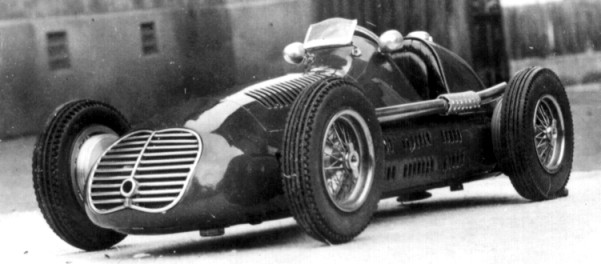
These pictures were taken by Henri with his home-made camera of superb Maserati 4CLTs built in these tough but very exciting and happy days. Over 100 were built in the 1950s for round-the-pole racing. It was the most popular model by far. One of these Maseratis was was sold at a Christies London Auction during 1997 for £6,900 pounds (see here http://www.christies.com/LotFinder/lot_details.aspx?from=salesummary&intObjectID=1440502&sid=e85df26b-35fb-4158-8d11-60b4a131a575 )
During the early days, we made a large number of Maseratis for round-the-pole racing. Henri was really keen on the 'Masers', but it was more of the popularity with the racers that meant we had to make so many more than other makes. We made 4CLs and later the 4CLT/48s, at the rate of one every ten days, as every process was jigged for repetition. The 'Masers' were beautiful cars and were showing a dominance in the GPs nearly equal to the Ferraris of these recent years. They also made a fine subject for a 1/12th-scale model. The wooden block to beat the bodies on had to be replaced when the 48s came out. Henri had taught me to make solid model aircraft when I was very young, insisting on me making cross-sectional templates for accuracy, and this came in very useful when I was given the job to carve the patterns. For true scale the thickness of the aluminium skin had to be subtracted everywhere the shell covered. The blocks were then split with a very fine saw to enable them to be removed after forming the body shell parts. Some adjustments and re-beating took place on the lower parts, after the blocks were removed. The 'Masers' were my favourites and to see the contemporary masters driving them around Goodwood or Silverstone from the pit-paddock area was an amazing experience. Among these drivers were Alberto Ascari, Prince Bira, Juan-Manuel Fangio, Stirling Moss et al. I saw Prince Bira drive one of these at Goodwood to win a race. He invited me to sit in his Aston Martin DB2 and I was amazed. He was most charming, a perfect gentleman who just wanted to share his joy with a young enthusiast. He certainly was a Prince among men.
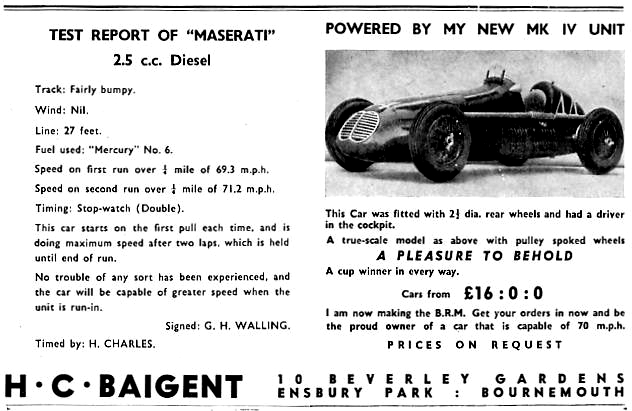
above, an advertisement from Model Cars Feb 1950. As you may notice, at that stage we were operating as H. C. Baigent.
above, a cutting from Modellismo Aug/Sept 1950 with photographs by Carlo Mallio Tabone of Rome showing one of our production, click to enlarge.


'Masers' capable of topping 70 mph, the rear attachment for the tether is clearly visible in the picture of No 21

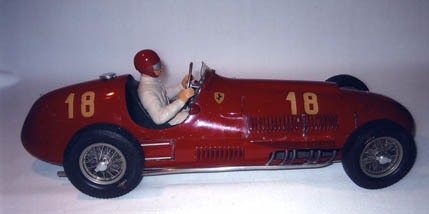

above left, our model of the 1950 Ferrari 375 GP during the build, and centre, the model as it is today (for full details of the model click here Ferrari 375 ) This car was Ferrari's first effort at Grand Prix racing. What a future that portended. The model was painted red, what else? and on the right; a drawing of the original car.
above, a reproduction of an article in Model Car News, Jan 1950, click on picture to enlarge to reading size

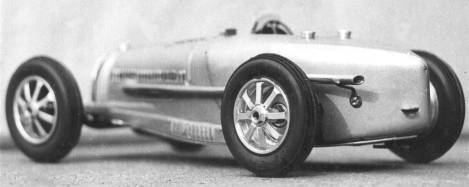


A few of the Bugattis that were made for round-the-pole racing in the 1950s. Top left, a type-43. Right, a type-35B. The two together were built in 1952 to near-scale, the left of this pair is a type-35B, while on the right is a type-33 ex-Jean-Pierre Wimille car, note the twin rear wheels. This was the car that killed 3 or 4 drivers. Finally, bottom right, a 3.3
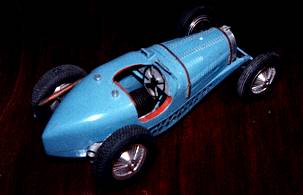
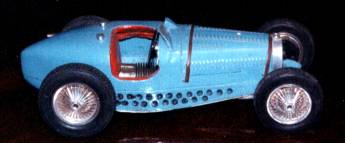
Rob Walker's Bugatti Type 59 GP after extensive refurbishment in the early 1960s, the wooden chassis was somewhat damaged by racing, this car was sold at a Christies London Auction during 1997 for £4.600 pounds,
above, 1950, the first model, ever, of the much heralded BRM.
I came home on leave from my squadron during 1950. Henri told me that Raymond Mays and some others were building a new Grand Prix car called the BRM. He had been asked to make a model of it to one-12th scale. The full-sized car was all very hush-hush, so I was sworn to secrecy. The shape of the body would not take our standard 2.5 cc ERE engine so he had to design a new one that could lay lower down. He had it finished and running in 3 working days, I know this because I was there, and even now, I can hardly believe it. Unfortunately, the full-size car was not very successful due to mistakes and mishaps I am pretty sure that he only made one model like this, but several for track-racing later.
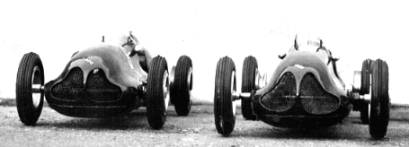
two early models of the E-type ERA for round-the-pole racing
above, an article from Model Maker October 1952 about our model of the Redex Special that Mike Hawthorn drove; does anyone know anything about this car? Or, where is the model now?
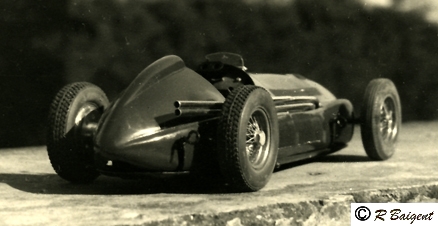


an Alfa Romeo type 158/9 made for an Italian client. As I featured strongly in its making, I would love to know where it is. Just the grill alone took me 3 weeks, working long hours, and several attempts, to make it correctly enough for Henri.
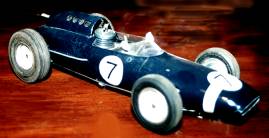
A 1961 model of a Lotus 65 as driven by Stirling Moss in 'Rob' Walker's full-size racing team
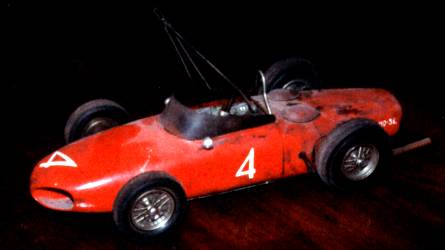
'Rob' Walker's cars took a considerable thrashing. This is the state of a 1961 'shark-nose' Ferrari Type 156 after RTP racing punishment. This car was was sold at a Christies London Auction during 1997 for £4,600 pounds,
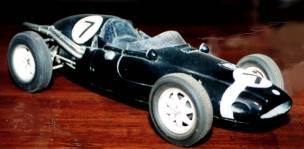
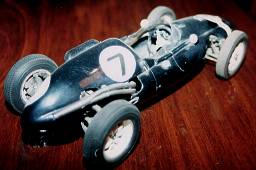
during 1958, 'Rob' Walker's full-sized racing team, with Moss as the first driver, took on a new Lotus with Coventry Climax engine. Moss always drove using his lucky No 7. Of course Walker had to have a model of it to race RTP, so he ordered one from Henri. It is pictured above after it had raced many times
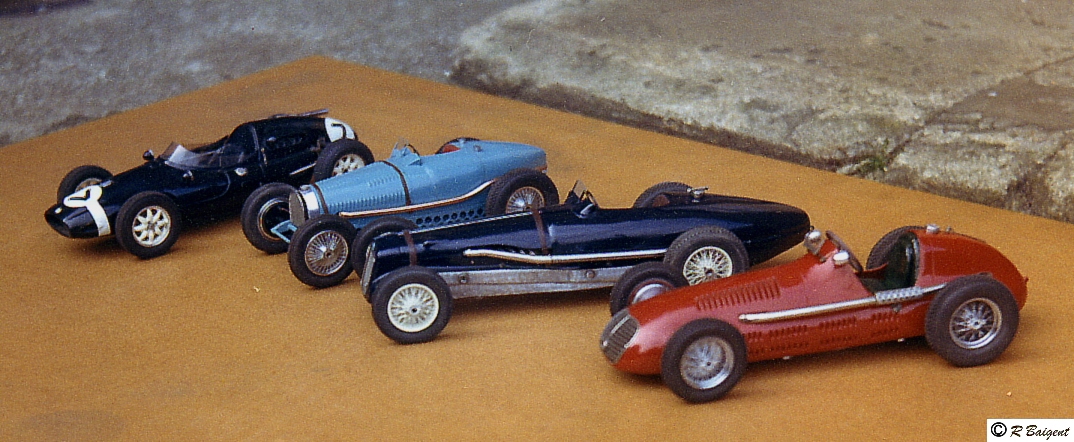
a quartet of Rob Walkers RTP models after refurbishment by Henri during 1960s. From L ot R: Moss's Lotus; Bugatti 33; Ex-Seaman Delage; and a Maserati 4CLT
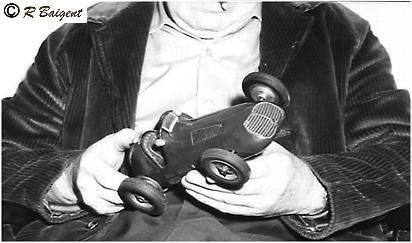
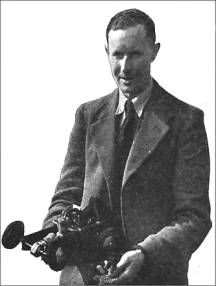
Henri always inspected our models personally before delivery and
R.H.R (Bob) Curwen after a cable breakage on a round-the-pole occasion, a highly respected friend and fellow member of the MRRC.
An article from Model Cars Feb 1950, click on pics to read article
click on images above to read text
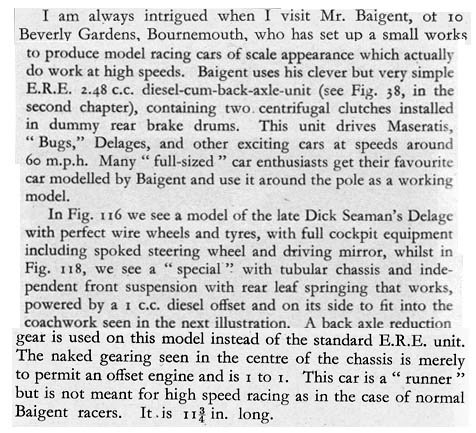
re-constructed text from Col Bowden's book on model diesel engines
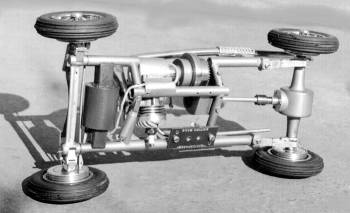
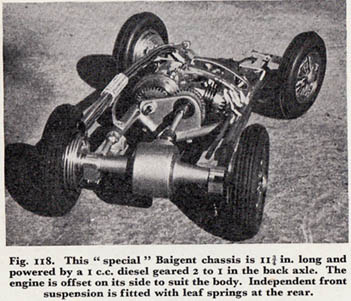
the special chassis referred to above
Graham Hill 'Stackpipe' BRM built for Rob Walker, click on images above for enlargements this model sold for £3,910 at Christies,
(see here: http://www.christies.com/LotFinder/lot_details.aspx?pos=9&intObjectID=1440503&sid= )
R.R.C. 'Rob' Walker was the main patron of Henri's early development, always encouraging and generous. Henri would not have survived the cash-flow problems if it had not been for 'Rob' Walker many times during the early years. He was always ready to drum up an order to help. I will always be enormously grateful to this wonderful gentleman. He was tall, handsome and very exciting, and always ready for a challenge. He used to turn up in all sorts of very expensive cars at our lowly abode. Among these was a beautiful Rolls Royce. A neighbours' Downe's Syndrome son smashed the lenses of the magnificent headlights with a pair of nut-crackers, and although 'Rob' was clearly dismayed, he passed it off with magnanimous indifference when he heard about the child's sad condition. I can still hear his exclamation when he saw any finished model car, "M-a-r-vellous!!", this drawn out with an very aristocratic accent. As a youth in my late-teens it was a very interesting and exciting time with all sorts of classic cars parked outside our gate. Rob had some delicious examples including a Hugo Tanin styled Delahaye Coupe (see photos below), a magnificent long Bugatti which was a La Royale, I think. Also, a straight-8 Delage which would go as fast in reverse as it did in the forward gears. It had one of the first electric gearboxes that I had seen. Peter Hampton used to call in a Straight-8 Bugatti Coupe which was so elegant. He had lost his right arm in a crash-landing in his Hawker Tempest on the beaches in the Normandy Landing in 1944, but he still managed to drive this brute of a car with the hand-brake on the right-hand side aided by an electric gearbox. He was another fine gentleman with loads of panache. He would put the Bugatti into reverse, at the flick of a switch and reverse the Bugatti back up our unmade-up cul-de-sac at about 60 mph with great aplomb! Another visitor was Kenneth MacAlpine who would come to visit with powered scale-models in mind, but I can't remember whether he ever bought one.
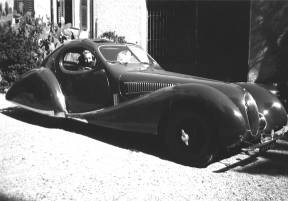
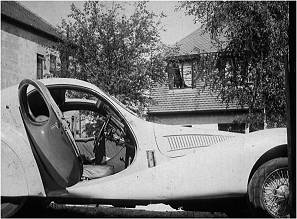
'Rob' Walker's Hugo Tanin Delahaye, in Monte Carlo, and later, outside our humble abode, just look at those lines, it looked fast and was fast! Whatever did our neighbours think?!!!
R.R.C. 'Rob' Walker was a regular contributor to the Motorsport Magazine in that era, which we took regularly and I would eagerly read his articles and fantasize my time away in the 'fast-lane'.